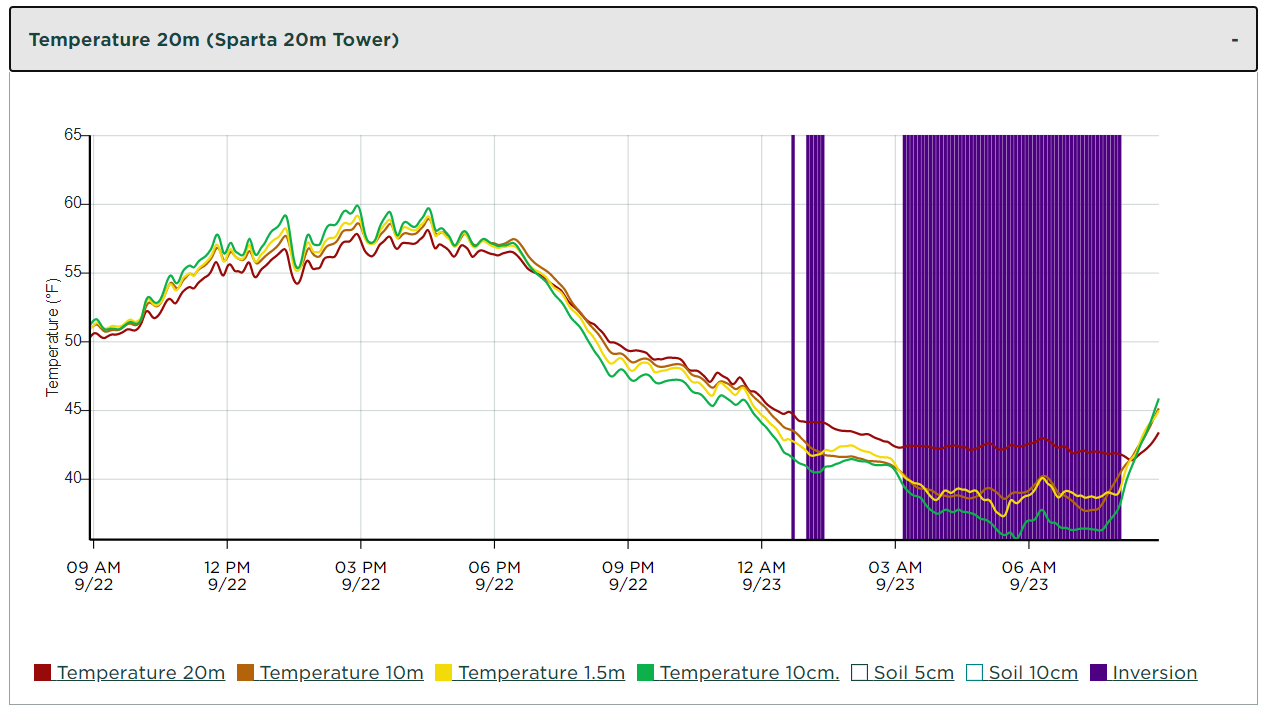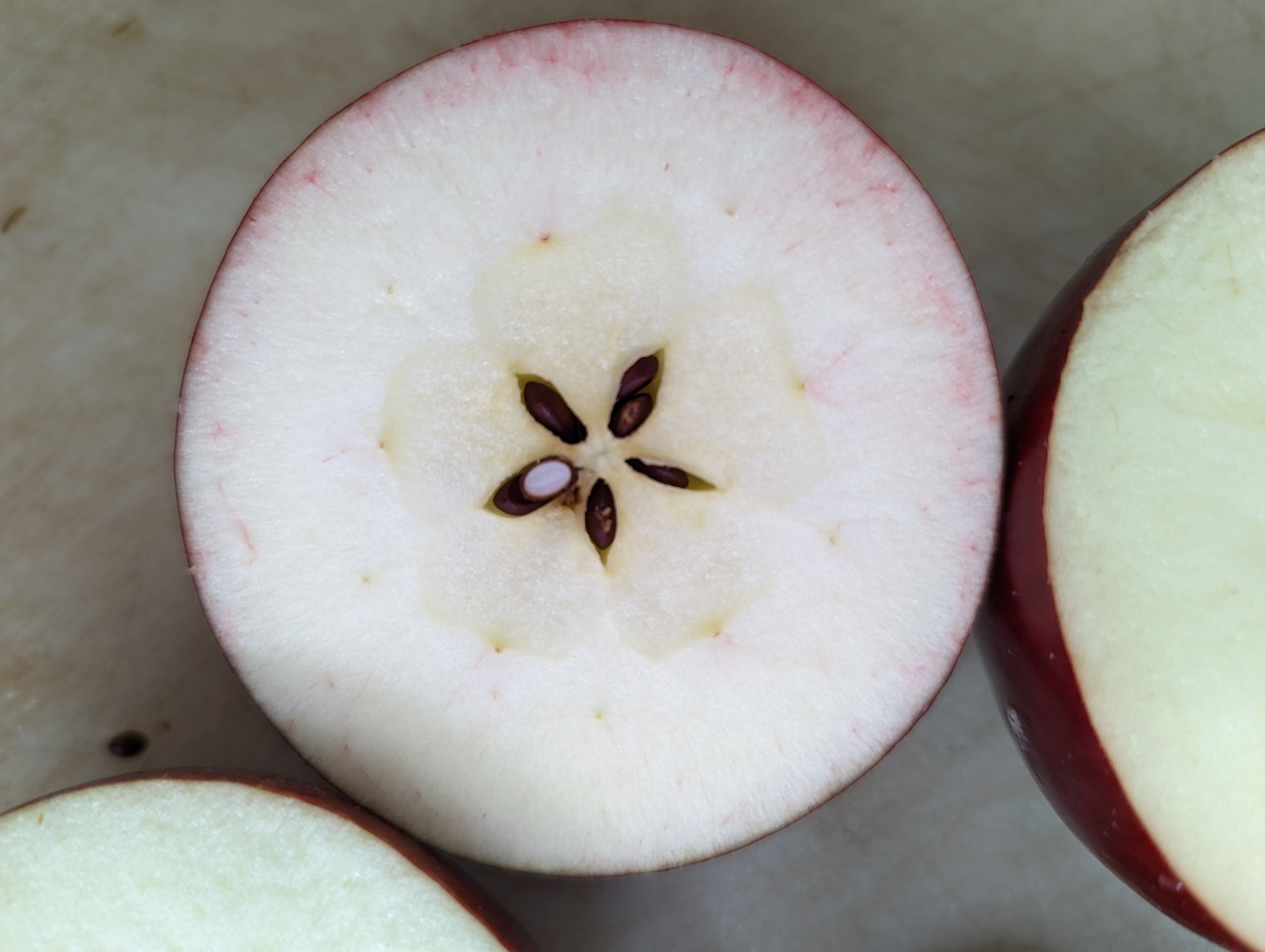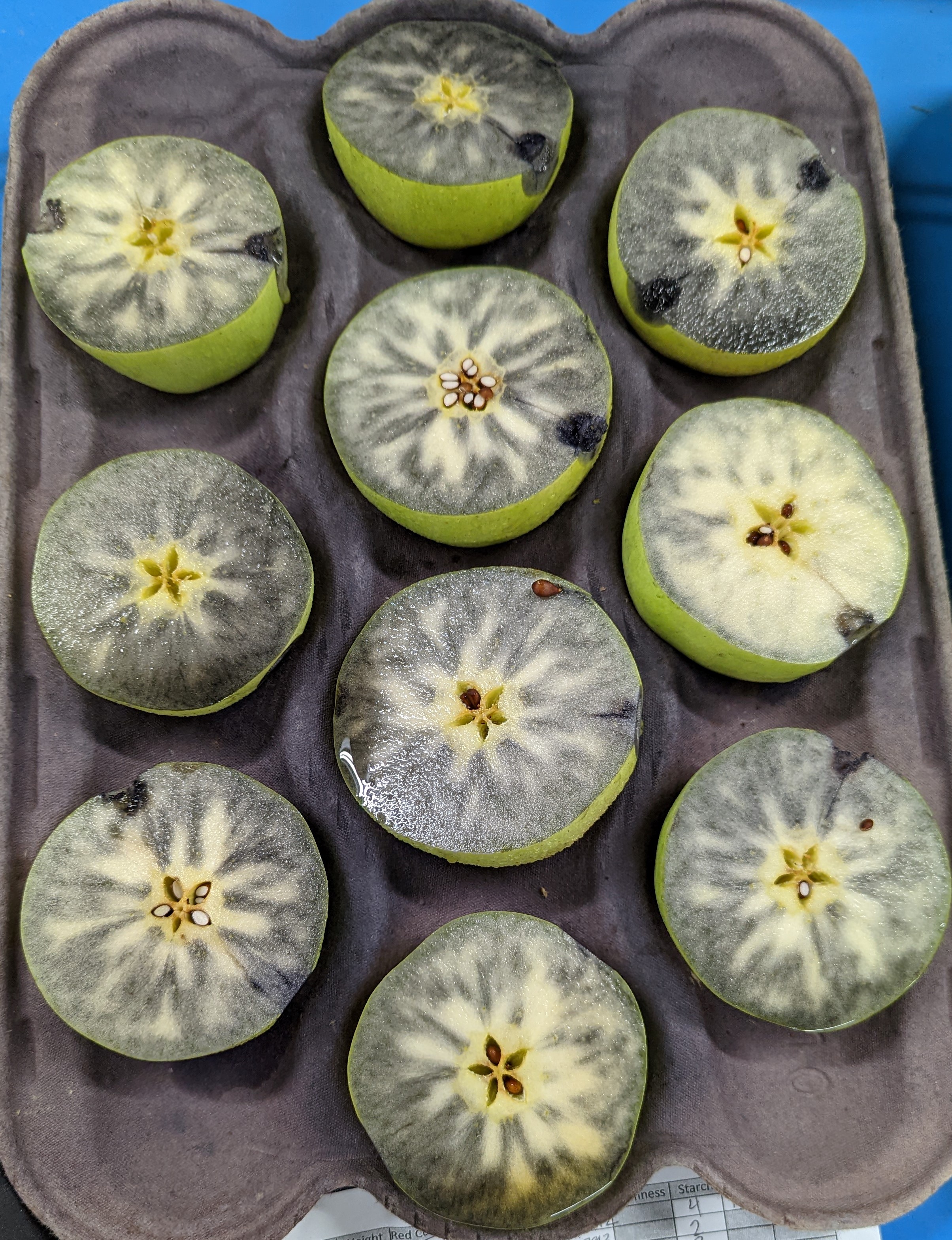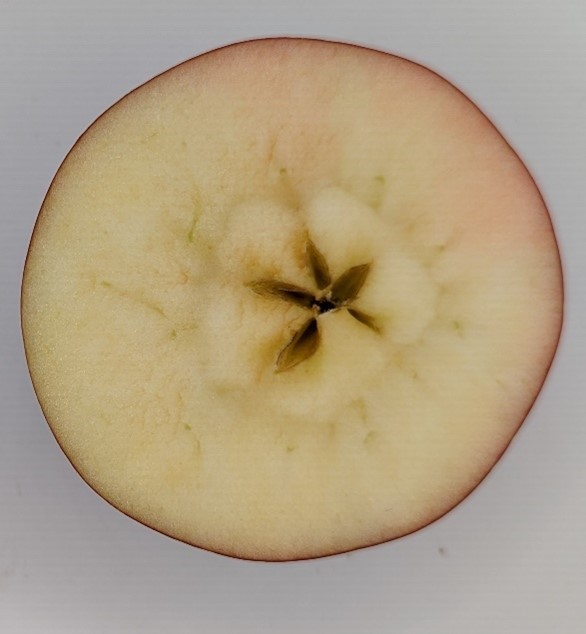Grand Rapids area apple maturity report – September 28, 2022
A dramatic change in weather this week. Harvest of Honeycrisp, Gala and McIntosh is nearly finished. Golden Delicious, Empire and Ambrosia are beginning. Red Delicious, Fuji and other varieties are right behind.

This is the ninth maturity apple maturity report for 2022. Reports are sent out every week (usually on Wednesdays), following the Michigan State University Extension fruit team apple maturity calls on Wednesday morning.
This week in the Grand Rapids area, harvest of Gala, Honeycrisp, and McIntosh is wrapping up. A large part of the crop has been picked; second and third picks are underway, as well as fruit treated with ReTain and Harvista. Testing this week included Empire, Jonathan, Jonagold, Golden Delicious, Red Delicious, Aztec Fuji, Ambrosia, Idared, Granny Smith, and Rome. Overall, fruit size is very good, crop load is excellent, and red color is developing very well.
Weather conditions in the Grand Rapids area took a dramatic turn this week to much more seasonable fall temperatures. It was hot at the beginning of the week, with high temperatures were in the 70s (F). Wednesday morning included storms with wind and isolated hail. See the NOAA Storm Prediction Center for storm reports. This was followed by a drop in temperature, with highs in the 60s from Thursday through the beginning of this week. Approximately 0.25 inches of precipitation was recorded in most locations over Sunday, Monday, and Tuesday. Expect cooler conditions to continue for the remainder of the week, with highs mostly in the 60s and lows in the 40s.
Chilling conditions. Temperatures fell to the low 40s and upper 30s in many places on Thursday and Friday mornings, Sept. 22 and Sept. 23. These temperatures have the potential to cause chilling injury in sensitive varieties. Temperatures for potential Honeycrisp chilling injury begin around 37 and are likely at 34. Other sensitive varieties include Jonathan, McIntosh, and Empire. Actual low temperatures recorded by Enviroweather stations are in the table below.
Chilling potential is based on research conducted by Randy Beaudry, summarized in this article about cool, fall nights and challenges for fruit storability. In general, Beaudry’s research found that fruit that sustained two nights of low temperatures experienced more chilling injury. This suggests that “low field temperatures slightly enhanced fruit sensitivity to chilling in storage.” In addition, “conditioning reduced chilling, ReTain increased the incidence of chilling, storage at 32 F (compared to 37F) increased chilling injury, and conditioning increased bitter pit incidence.” In general, we believe the risk of chilling injury due to weather conditions in the Grand Rapids area is low because low temperatures were not sustained for many hours and have not been repeated for many nights. Lower lying blocks, where cool air pools are at higher risk.
Forecasts indicate there is the potential for chilling temperatures again this week, with the lowest temperatures predicted for Thursday, Friday, and Saturday.
|
Temperatures recorded by Enviroweather stations (F) on the morning of Sept. 23, 2022. | ||||||||||
|---|---|---|---|---|---|---|---|---|---|---|
|
Weather Station |
12-1AM |
1-2AM |
2-3AM |
3-4AM |
4-5AM |
5-6AM |
6-7AM |
7-8AM |
8-9AM |
9-10AM |
|
Sparta |
42.5 |
41.4 |
41.7 |
39.4 |
39 |
38.3 |
39.2 |
38.7 |
42.6 |
49.6 |
|
Aetna - Fremont |
41.8 |
40.7 |
40.4 |
40.1 |
39.7 |
38.7* |
37.3* |
36.4* |
42.2* |
47.2* |
|
Alpine |
44.3 |
42.8 |
43.1 |
42.8 |
40.1* |
37.6* |
37.4* |
38.5* |
43* |
48* |
|
Belding |
43.3 |
42.8 |
41.3 |
39.9 |
39.3 |
39 |
39.2 |
38.1 |
43.9 |
48.5 |
|
Clarksville (CRC) |
43.4 |
42.3 |
40.7 |
39.6 |
38.8* |
38.6* |
37.1* |
36.4* |
40* |
46.7* |
|
Conklin |
44.9 |
44.8 |
43.1 |
42.7 |
42.1 |
41 |
40.9 |
42.2 |
45.4 |
49.2 |
|
Fremont |
43.1 |
42.6 |
39.7 |
39 |
37.6* |
36.9* |
35.8* |
35.5* |
40.2* |
45.8* |
|
Grant |
42.5 |
42.4 |
40.9 |
38.1 |
36.4* |
35.3* |
33.9** |
33.6** |
35.6** |
43.1** |
|
Kent City |
43.6 |
41.5 |
39.9 |
38* |
37* |
36.3* |
35.7* |
35.7* |
39.7* |
48.3* |
|
Reeman Fremont West |
42.8 |
43.1 |
41.9 |
41.3 |
39.8 |
38.6 |
38* |
38* |
40.3* |
46.9* |
|
Sparta 20m Tower |
43.1 |
42.1 |
41.8 |
39.5 |
39.1 |
38.2 |
39.3 |
38.8 |
42.8 |
48 |
|
Sparta - North |
43.2 |
42.4 |
42.5 |
41.2 |
39.6 |
39 |
39* |
37.7* |
39.8* |
46.5* |
|
Standale |
42 |
43.2 |
43.1 |
41.3 |
38.3 |
36.9* |
36.8* |
36.2* |
40.7* |
49* |
* Temperature was 37 F or less (possible chilling injury).
** Temperature was 34F or below (ideal temperatures for chilling).

The majority of fruit were sampled from untreated blocks (no ReTain or Harvista applied). However, a couple of samples this week included fruit that were treated, as it is becoming more difficult to find untreated fruit.
How to read maturity tables
Each week, we test apple varieties that are nearing maturity in the Grand Rapids. We are reporting average values for several samples for each variety. Maximum and minimum values are included for the highest and lowest individual fruits evaluated for each, to give a full spectrum of the maturity. All samples included in the reports have been untreated with ReTain or Harvista, unless otherwise noted.
- Predicted apple harvest dates for 2022 from MSU
- More information on harvest management tools and timings can be found in this article.
- Guidelines from MSU to check for apple maturity in your own orchard, including specific pressure and starch recommendations by variety.
- Predicting apple maturity and starch chart from Cornell University
- Starch chart for Honeycrisp Apples developed by Washington State University.
Empire (predicted harvest date: Sept. 25)
Fruit is being harvested in most locations this week. Depending on the block fruit is is ready for long term storage or direct market and shorter storage. Again this week, red color is excellent and a few fruit are producing significant ethylene. Firmness has decreased very little this week, with averages near 16-17lbs. Starch clearing is variable, with samples averaging just below 4. Sugars are still a bit low but acceptable.
|
Collection Date |
Fruit Weight (g) |
Red Color (%) |
Background color (5-1) |
Ethylene (% >0.2ppm) |
Firmness (lbs) |
Starch (1-8) |
Soluble Solids (°Brix) |
|
Aug 29 |
160 (160-160) |
50 (60-40) |
4.8 (5-4) |
0% |
18.3 (20.5-16.6) |
1.7 (1-2) |
9.9 (9.9-9.9) |
|
Sep 5 |
150 (150-150) |
62 (70-60) |
4.8 (5-4) |
0% |
19.3 (22-16.9) |
2 (2-2) |
10.4 (10.4-10.4) |
|
Sep 12 |
NT |
58 (70-50) |
4.4 (6-3) |
0% |
17 (19.5-15.5) |
2 (2-2) |
10.6 (10.6-10.6) |
|
Sep 19 |
NT |
65.3 (80-50) |
4.13 (5-2) |
0-10% |
16.7 (21.7-13.97) |
2.9 (1-4) |
10.4 (11-9.5) |
|
Sep 26 |
173.3 (140-190) |
64.6 (50-80) |
4 (5-2) |
0-10% |
16.4 (13.4-22.2) |
2.5 (1-5) |
10.5 (9.8-11) |
Jonathan (predicted harvest date: Sept. 27)
This variety is mature this week. Red color is very good, as expected for this variety. A little under half of fruit tested were producing a significant amount of ethylene. Sugars improved a bit again this week, but are still lower than ideal. Pressure were lower this week, with averages at 13-14lbs. Recommended pressures are 14-16 depending on the intended storage time. Starch was more advanced, with averages of 5-6. In two of the locations tested this week fruit we observed bleeding in a couple of fruit.
|
Collection Date |
Fruit Weight (g) |
Red Color (%) |
Background color (5-1) |
Ethylene (% >0.2ppm) |
Firmness (lbs) |
Starch (1-8) |
Soluble Solids (°Brix) |
|
Aug 29 |
150 (170-130) |
75 (60-90) |
4.7 (5-4) |
0% |
17.7 (24.1-14.6) |
1.95 (3-1) |
9.5 (9.8-9.2) |
|
Sep 5 |
165 (180-150) |
78 (60-90) |
5 (5-5) |
0% |
16. 5 (19.7-14.6) |
2.8 (6-2) |
10.0 (10.1-9.9) |
|
Sep 12 |
NT |
88 (70-90) |
3.2 (5-2) |
30% |
15.7 (18.5-13.3) |
4.0 (7-1) |
10.8 (10.9-10.7) |
|
Sept 19 |
NT |
80.23 (70-90) |
3.6 (5-2) |
10-20% |
15.5 (20.3-12.5) |
4.7 (7-2) |
11.3 (11.7-10.7) |
|
Sept 26 |
180 (170-190) |
79.3 (70-90) |
3.7 (5-1) |
0-40% |
14 (9.6-17.7) |
5.7 (3-7) |
11.8 (11.5-12.3) |

Jonagold (predicted harvest date: Sept. 27)
This variety is showing more signs of maturity. Most samples collected this week were treated with ReTain—very few Jonagolds are untreated in the area this year. Red color development improved this week, but background is still fairly green. Ethylene was only being produced in significant amounts in one sample, which was NOT treated with ReTain. Sugars are a bit better, but still lower than ideal, and flavor is better, but still improving. Pressure was still very good in tested fruit; recommended pressure for this variety is 15-17, depending on the intended storage time. Starch clearing was more advanced this week with averages between 5.2-5.9. Untreated fruit is ready for harvest, based on internal indicators (ethylene and starch). Treated fruit needs just a bit more time before harvest for shorter storage or direct market, but is ready for harvest for longer storage.
|
Collection Date |
Fruit Weight (g) |
Red Color (%) |
Background color (5-1) |
Ethylene (% >0.2ppm) |
Firmness (lbs) |
Starch (1-8) |
Soluble Solids (°Brix) |
|
Aug 29 |
215 (220-210) |
18.8 (40-5) |
4.7 (5-3) |
0% |
20.2 (23.8-16.9) |
1.45 (2-1) |
10.2 (10.4-9.9) |
|
Sep 5 |
235 (250-220) |
26 (40-10) |
4.1 (5-3) |
0-5% |
19.4 (22.2-16.5) |
2.35 (4-1) |
10.1 (10.2-10) |
|
Sep 12 |
NT |
24 (50-10) |
4.2 (5-3) |
0% |
17.2 (21-14.7) |
2.9 (5-1) |
10.6 (11.6-10) |
|
Sep 19 |
NT |
48 (60-20) |
3.85 (5-2) |
0-20% |
17.8 (22.7-14.8) |
4.1 (6-3) |
11.1 (11.6-10.6) |
|
Sep 26 |
280 (250-300) |
52.5 (30-70) |
4.2 (5-3) |
0-50% |
15.8 (12.6-20.6) |
5.8 (4-8) |
11.4 (11.3-12) |
Red Delicious (predicted harvest date: Oct. 1)
This variety is nearly mature in most locations. Red color is very good, background color is a bit lighter this week. Only one of the fruit tested this week was producing significant amount of ethylene. Starch clearing is a bit more advanced, with averages between 2.0 and 2.5. Sugars are still a bit low. Overall pressure is still good, aside from a couple of softer fruit. Recommended pressures are 16-18 depending on the intended storage time.
|
Collection Date |
Fruit Weight (g) |
Red Color (%) |
Background color (5-1) |
Ethylene (% >0.2ppm) |
Firmness (lbs) |
Starch (1-8) |
Soluble Solids (°Brix) |
|
Aug 29 |
165 (190-140) |
61 (80-30) |
4.4 (5-4) |
0% |
18.2 (21.3-15.6) |
1.15 (2-1) |
8.1 (8.2-7.9) |
|
Sep 5 |
180 (180-180) |
51 (60-40) |
5 (5-5) |
0% |
16.4 (17.5-15) |
1.6 (2-1) |
7.7 (7.7-7.7) |
|
Sep 12 |
NT |
68.5 (90-50) |
3.7 (5-3) |
0% |
16.8 (18.4-15.1) |
1.5 (2-1) |
8.35 (8.7-8.0) |
|
Sep 19 |
NT |
69 (80-60) |
3.4 (4-2) |
0-10% |
17.0 (20.9-13. 4) |
2.2 (4-1) |
8.9 (9.8-8.5) |
|
Sept 26 |
210 (160-250) |
75 (60-90) |
3 (5-1) |
0-10% |
16.7 (14.1-21.3) |
2.1 (1-5) |
9.4 (8.8-11) |
Golden Delicious (predicted harvest date: Oct. 3)
This variety is still ready for harvest in most locations where fruit are not treated. Background color lighter this week. Just a touch of pink is present on the blush side of a few fruit. Ethylene was only being produced in fruit from one location this week. Starch clearing is was more advanced, and averaged between 3.4 and 5.7 this week. The pattern in this variety can also be a bit different than the traditional McIntosh starch staining, with flesh clearing before the entire core is clear. Overall, pressures are still very good, averaging from 15.4-19.0. Recommended pressures for this variety are 15-17 depending on the intended storage time. Sugars improved considerably in most locations this week. Varietal flavor is very good in this variety.
|
Collection Date |
Fruit Weight (g) |
Red Color (%) |
Background color (5-1) |
Ethylene (% >0.2ppm) |
Firmness (lbs) |
Starch (1-8) |
Soluble Solids (°Brix) |
|
Aug 29 |
180 (180-180) |
2.5 (5-0) |
4.5 (5-4) |
0% |
19.2 (21.1-16.6) |
1.2 (2-1) |
10.6 (10.6-10.6) |
|
Sep 5 |
190 (200-170) |
1.3 (5-0) |
4.1 (5-3) |
0% |
18.3 (24.1-15.6) |
2.0 (3-1) |
10.2 (11-9.8) |
|
Sep 12 |
NT |
2.7 (10-0) |
4.2 (5-3) |
10% |
18.1 (20.7-15.0) |
1.8 (6-1) |
10.9 (11.7-10.0) |
|
Sep 19 |
NT |
3 (5-0) |
4.2 (5-3) |
0% |
17.1 (20.4-14.2) |
2.9 (7-1) |
12.5 (14.1-11.1) |
|
Sep 26 |
207.5 (180-220) |
4.8 (0-20) |
3.9 (5-2) |
0-10% |
16.8 (14.1-23) |
4.7 (2-7) |
12.1 (10.8-13.5) |

Aztec Fuji
We sampled this variety for the second time this week. While it usually is often left later in the season, mostly for color, this variety often is mature soon after Red Delicious. Red color was much better this week, but background color was a bit green. Overall fruit is still very firm, with samples averaging 18-19 lbs. Sugars were a little higher this week, and varietal flavor is beginning to develop. Starch has already begun clearing, with averages between 2.7 and 3.7 this week. Fruit is likely to mature earlier than our predicted harvest date.
|
Collection Date |
Fruit Weight (g) |
Red Color (%) |
Background color (5-1) |
Ethylene (% >0.2ppm) |
Firmness (lbs) |
Starch (1-8) |
Soluble Solids (°Brix) |
|
Sep 19 |
NT |
44.5 (60-20) |
4.45 (5-3) |
0-30% |
19.3 (24.7-16.0) |
2.9 (4-2) |
10.5 (11.2-9.9) |
|
Sep 26 |
227.5 (200-260) |
62 (50-70) |
4.1 (5-2) |
0-30% |
18.7 (15.7-25.2) |
3.2 (2-5) |
11.5 (10-15.4) |
Idared (predicted harvest date: Oct. 6)
We sampled this variety for the first time this week. Overall, fruit is still very green, with red color development variable depending on location. Pressure was a bit lower this week, with samples averaging 14.3-16.2 lbs. Sugars are still a bit low, although this is a more acidic variety. Fruit is still very starchy, with averages between 1.2-2.1 this week.
|
Collection Date |
Fruit Weight (g) |
Red Color (%) |
Background color (5-1) |
Ethylene (% >0.2ppm) |
Firmness (lbs) |
Starch (1-8) |
Soluble Solids (°Brix) |
|
Sep 19 |
NT |
47.3 (70-30) |
4.525 (5-3) |
0-30% |
16.1 (20.5-13.4) |
1.5 (3-1) |
10.3 (10.4-9.9) |
|
Sep 26 |
222.5 (170-270) |
56.2 (30-70) |
3.8 (5-2) |
0-10% |
15.5 (12.7-18.6) |
1.6 (1-4) |
10.1 (9.5-10.4) |
Ambrosia
This variety is nearly mature for longer term storage. Red color development is much better, and background color is beginning to change from green to a lighter green-yellow. Fruit is still fairly firm, with samples averaging near 17lbs. Sugars are a bit better than last week, and varietal flavor is good. Starch clearing is continuing gradually, with averages for all samples averaging 2.3-3.0 this week, and some fruit still very starchy. A few fruit were producing significant amounts of ethylene this week, but this seems to be a variety that produces high amounts of ethylene before harvest, based on our work last year and this year so far.
Detailed recommendations for Ambrosia harvest have been made by WSU and ONFruit. Both indicate that it is important to harvest this variety before the background color changes to yellow, if it is intended for long term storage. Starch clearing may not be the best indicator of maturity. Instead, recommendations are to use DA (Delta Absorbance) as an indicator. For long term storage, a range of 0.7-0.5 is recommended. In two locations we tested this week, fruit was near 0.7, indicating it is ready to be harvested or should be in the next few days.
|
Collection Date |
Fruit Weight (g) |
Red Color (%) |
Background color (5-1) |
Ethylene (% >0.2ppm) |
Firmness (lbs) |
Starch (1-8) |
Soluble Solids (°Brix) |
|
Sep 12 |
NT |
28 (50-10) |
3.85 (5-3) |
0% |
19.1 (22.4-17.1) |
1 (1-1) |
10.3 (10.8-9.8) |
|
Sep 19 |
NT |
38.5 (60-10) |
3.85 (5-3) |
20-50% |
17.9 (22.2-15.1) |
2.1 (3-1) |
11.1 (11.3-10.9) |
|
Sep 26 |
220 (210-230) |
42.5 (30-60) |
4.3 (5-3) |
20-50% |
17.3 (14.9-19.5) |
2.6 (1-5) |
10.7 (10.4-11) |
Granny Smith
We sampled this variety for the second time this week. Fruit is beginning to show signs of maturity but is still very green. Fruit is still very firm, with samples averaging around 19-20lbs. Sugars are still low, and fruit tastes extremely sour. Starch clearing is just beginning, with averages for all samples near 2.0 this week. None of the fruit tested this week were producing significant amounts of ethylene.
|
Collection Date |
Fruit Weight (g) |
Red Color (%) |
Background color (5-1) |
Ethylene (% >0.2ppm) |
Firmness (lbs) |
Starch (1-8) |
Soluble Solids (°Brix) |
|
Sep 19 |
NT |
2.5 (5-0) |
4.4 (5-3) |
0% |
19.8 (22.7-16.5) |
2.2 (3-1) |
9.3 (10-8.6) |
|
Sep 26 |
225 (200-250) |
12.5 (10-30) |
4.5 (5-4) |
0% |
19.5 (16.9-22.2) |
1.9 (1-2) |
9.8 (9.3-10.3) |
Law Rome (predicted harvest date: Oct. 11)
We sampled this variety for the second time this week. Overall, fruit is still a bit immature. Red color is developing nicely, but background color is still a fairly green. Fruit is still very firm, with samples averaging near 20lbs. Sugars are still low. Starch clearing is just beginning, with averages for all samples near 2.0 this week. None of the fruit tested this week were producing significant amounts of ethylene. This variety is susceptible to red color bleeding from the skin into the flesh, but we did not observe this in any samples this week.
|
Collection Date |
Fruit Weight (g) |
Red Color (%) |
Background color (5-1) |
Ethylene (% >0.2ppm) |
Firmness (lbs) |
Starch (1-8) |
Soluble Solids (°Brix) |
|
Sep 19 |
NT |
61 (70-40) |
4.5 (5-3) |
0% |
18.9 (23.4-15.4) |
2.4 (3-1) |
10.2 (10.5-9.9) |
|
Sep 26 |
190 (180-200) |
69.5 (40-90) |
4.6 (5-3) |
0% |
22 (19.3-25.5) |
2.2 (2-4) |
10.5 (10.2-10.8) |

Apple maturity sampling parameters
- Ethylene (% fruits with internal ethylene over 0.2 ppm) = indicates when ethylene begins to influence fruit ripening and it cannot be held back easily after this is reached.
- Color % = the visual percentage of red color from 0 to 100; range is of all fruits tested. Indicates surface area covered in red and intensity of red color.
- Background color: 5 = Green, 1 = Yellow; range is of all fruits tested.
- Firmness in pounds pressure = measured with a Güss Fruit Texture Analyzer; range is of all fruits tested.
- Starch: 1 = all starch, 8 = No starch; range is of all fruits tested. Using Cornell Starch Iodine Index Chart.
- Starch For Honeycrisp: will typically be rated using the standard Cornell SPI scale (1-8). However, a separate starch chart for Honeycrisp Apples developed by Washington State University (scale 1-6) also exists.
- Brix = % sugar measured with Atago PAL-1 Pocket Refractometer
Looking for more? View Michigan State University Extension’s Apple Maturity page for regional reports throughout the state and additional resources.
|
Suggested firmness and starch index levels for long-term and shorter-term controlled atmosphere (CA) storage by variety. |
|||||
|
Variety |
Firmness (pounds)* |
Starch Index* |
|||
|
Short CA |
Mid-CA |
Long CA |
Mature |
Over mature |
|
|
McIntosh |
14 |
15 |
16 |
5 |
7 |
|
Gala |
16 |
17 |
18 |
3 |
6 |
|
Honeycrisp |
15 |
16 |
17 |
3.5 |
6 |
|
Empire |
14 |
15 |
16 |
3.5 |
6 |
|
Early Fuji |
16 |
17 |
18 |
3 |
7 |
|
Jonagold |
15 |
16 |
17 |
3.5 |
5.5 |
|
Jonathan |
14 |
15 |
16 |
3.5 |
5.5 |
|
Golden Delicious |
15 |
16 |
17 |
3 |
6.5 |
|
Red Delicious |
16 |
17 |
18 |
2.5 |
6 |
|
Idared |
14 |
15 |
16 |
3.5 |
6 |
|
Fuji |
16 |
17 |
18 |
3 |
7 |
|
Rome |
15 |
16 |
18 |
3 |
5.5 |



 Print
Print Email
Email